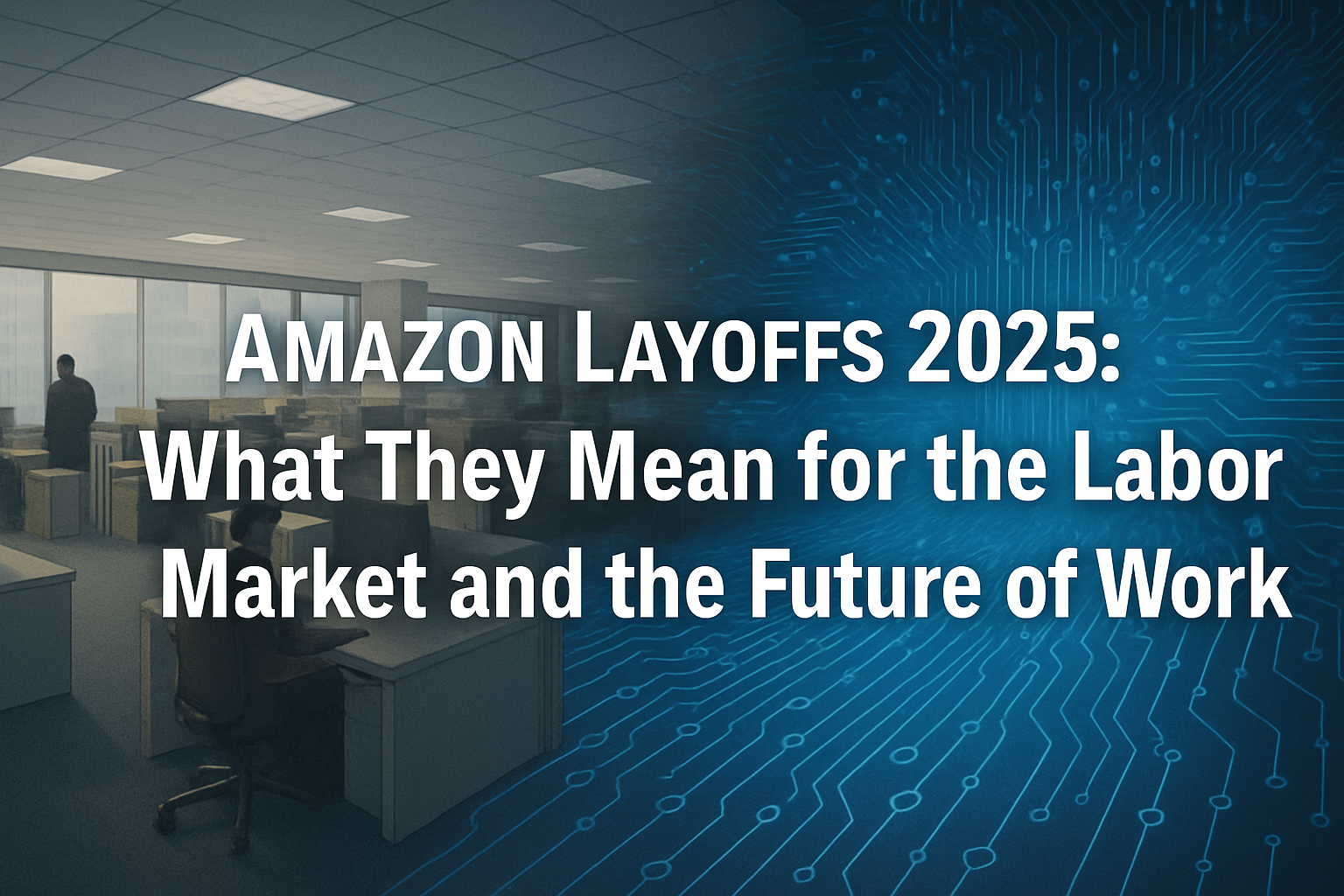Amazon’s 2025 layoffs are once again making headlines — and this time, the ripple effects are much bigger than one company. The latest round of cuts, affecting thousands of corporate and tech employees, reflects not only Amazon’s internal restructuring but also a wider labor market shift driven by automation, artificial intelligence (AI), and post-pandemic normalization.
What’s Happening Inside Amazon
Amazon has been steadily trimming its workforce throughout 2025, marking one of its most aggressive restructuring efforts since the pandemic hiring boom.
- AWS (Amazon Web Services) has laid off hundreds of employees across AI, analytics, training, and marketing divisions (Reuters, July 17, 2025).
- HR and PXT (People Experience & Technology) could lose up to 15% of staff, one of the largest departmental reductions so far (Economic Times, Oct 2025).
- Managerial positions are being cut by roughly 13%, part of CEO Andy Jassy’s effort to “flatten” the corporate structure.
- Communications and sustainability teams have also been affected, signaling that cuts are not limited to tech or HR.
These layoffs follow Amazon’s earlier eliminations of 27,000 jobs between 2022 and 2024 — but this new wave is more strategically focused on roles considered replaceable by AI or internal automation systems.
How This Reflects a Shifting Labor Market
Amazon’s cuts are not happening in isolation. They reflect deep changes reshaping the entire white-collar labor market in 2025:
- AI Is Replacing, Not Just Augmenting, Jobs
Across industries, automation and AI tools are beginning to replace mid-level roles rather than merely assist them. In Amazon’s case, HR analytics, training coordination, and even parts of marketing are now being handled by AI systems that analyze performance, forecast demand, or manage internal workflows.
According to the U.S. Bureau of Labor Statistics (BLS), employment in tech and management support roles fell 2.8% year-over-year as of September 2025 — the largest decline in over a decade.
- The Corporate Job Market Is Cooling
While unemployment remains historically low at 4.2%, demand for corporate professionals (HR, marketing, operations, middle management) has weakened significantly. Companies like Google, Meta, and Microsoft are all pursuing similar “efficiency” drives, trimming layers of oversight and prioritizing technical specialists over generalists.
Recruiters note that Amazon’s layoffs have flooded the market with highly skilled tech and operations professionals, increasing competition for fewer corporate openings.
- Blue-Collar and Logistics Roles Are Holding Steady
Ironically, while Amazon’s corporate teams shrink, the company continues hiring in warehousing, logistics, and delivery to support e-commerce and fulfillment growth. This mirrors a broader national trend: service and supply-chain jobs remain strong, while office jobs stagnate.
- Pressure to Upskill
The cuts highlight the growing premium on AI fluency and technical adaptability. Employees in HR, marketing, and administration who can integrate AI tools into their workflow are more likely to keep their jobs or transition to new roles.
As one tech labor analyst put it in The Wall Street Journal (Sept. 2025):
“We’re watching a corporate middle class get hollowed out by automation. The next three years will define who adapts and who gets left behind.”
Broader Economic Implications
Economists are split on whether this represents a temporary correction or a lasting redefinition of the labor market.
- Optimists argue Amazon’s AI adoption will drive long-term productivity gains, allowing for new job creation in emerging tech and automation support fields.
- Skeptics warn of a “white-collar recession” — a permanent loss of mid-level jobs that won’t return, even as overall GDP grows.
Either way, the tech industry’s headcount reductions — over 120,000 layoffs globally across major firms in 2025 alone — are reshaping expectations for job stability and career progression in corporate America.
What It Means for Workers
- Job seekers should expect a more competitive hiring market for corporate roles, especially in HR, marketing, and management.
- Upskilling in AI tools, data analytics, and process automation will be key to staying employable.
- Tech-adjacent fields (cloud infrastructure, AI training, cybersecurity) are still growing — but hiring has become more selective and performance-driven.
For those already inside large corporations, Amazon’s approach may signal what’s ahead elsewhere: leaner teams, flatter hierarchies, and increasing reliance on automation.
Amazon’s Layoffs and the Labor Market in 2025
- Amazon is cutting thousands of jobs across AWS, HR, and management to reduce costs and accelerate AI integration.
- These layoffs reflect a broader trend: corporate and tech job markets are tightening, even as automation surges.
- White-collar professionals face rising competition, while blue-collar and logistics jobs remain stable.
- The shift underscores an urgent need for digital upskilling and adaptability in a changing economy.
FAQ
Q: How do Amazon’s layoffs compare to other tech firms in 2025?
Amazon’s cuts are among the largest, but similar moves are underway at Meta, Microsoft, and Salesforce as companies adopt AI-driven efficiency strategies.
Q: Is this the start of a broader job recession?
Not exactly — overall employment remains healthy — but corporate job growth has slowed sharply as companies streamline and automate.
Q: What skills are in highest demand now?
AI literacy, cloud computing, cybersecurity, and data analytics are top priorities for employers across sectors.
Q: Will these layoffs continue into 2026?
Analysts expect at least one more wave of restructuring in early 2026 as AI tools mature and companies re-evaluate staffing needs.

